Did you just catch a few red spots on the floor? Or on your furniture? Don’t worry just read this article about Dogs In Heat and you will know how to deal with this phase of dog periods.
As sentimental as getting your dog’s first period can be, it can also be extremely overwhelming when you have no idea what do to or how to help her.
But, the first question that arises is “Do dogs get periods? Are they called dog periods?”
No, they don’t. In female humans, every month or so the uterus gets a thick lining around it to foster a fertilized egg if the woman gets pregnant.
When the egg doesn’t get fertilized, the lining or the tissue starts to break and hence, the bleeding occurs. This IS NOT the case for dogs.
Dogs do not have periods, per se, they have something called “the heat”. This is also known as the “estrus” cycle.
The blood which is released during the dog’s heat is part of an entirely different process than that which occurs in human females.
In female dogs, the reproductive organs and genitals are supplied with a surplus of blood which prepares them for breeding, due to which in the dogs in heat bleeding results.
“Do dogs in heat get cramps?” No, the swelling of the vulva is non-painful.
So even though these discharges of blood may be parallel in nature, they’re not happening for the same reason. So no, they are not called dog periods.
Table of Contents
When Do Dogs Go In Heat?
It usually occurs after six months, in smaller breeds whereas in larger breeds it can occur after a year too. When you see a female dog in heat, it means her body is maturing and is ready for breeding.
How Long Do Dog Periods Last?
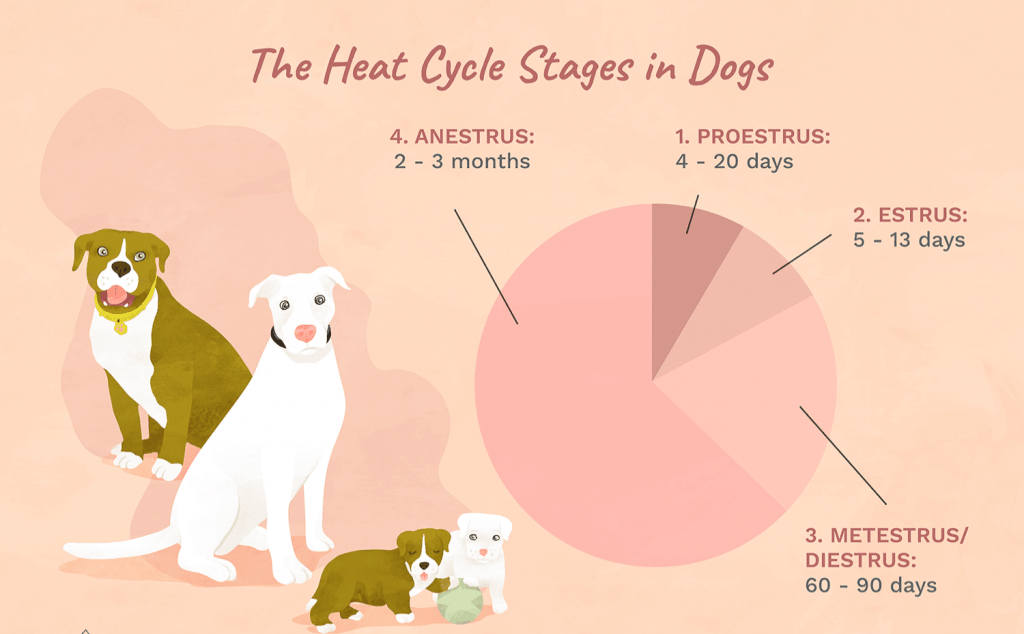
They last about 3-4 weeks, the bleeding alone. They go through something called the Estrus cycle, which is explained below.
What Is The Estrus Cycle?
Commonly referred to as coming into heat, dogs have something called the estrus cycle.
If your dog is not spayed, she will go through the estrus cycle twice every year. Some small dog breeds are also said to go through estrus three or four times a year, but larger dogs go through this only twice.
While humans go through estrus every 28 days, in dogs it is about 180 days, around the estimate. But just like in humans, sexual maturity is not timed in dogs either.
When female dogs are in heat, male dogs tend to be receptive towards mating whereas female dogs are certainly not receptive towards mating when experiencing estrus.
There may be some bloody discharge from your dog’s vagina, due to the ingurgitation of the genitals with blood in preparation for fertilization and mating.
So, here is how this is “heat” or the “estrus cycle” from menstruation.
In menstruation, there is release or absorption of the uterine lining in a female mammal.
But in dogs, if mating and fertilization do not occur the nutrient lining of the uterus which thickens for the advent of fertilization get absorbed back into the dog, it isn’t released.
This is called covert menstruation.
There is no menopause in dogs, so the “estrus cycles” do not stop.
Older female dogs will continue to experience heat, but the cycles will be further part, and fertility will gradually decrease.
Effect Of The Estrus Cycle On Males Dogs
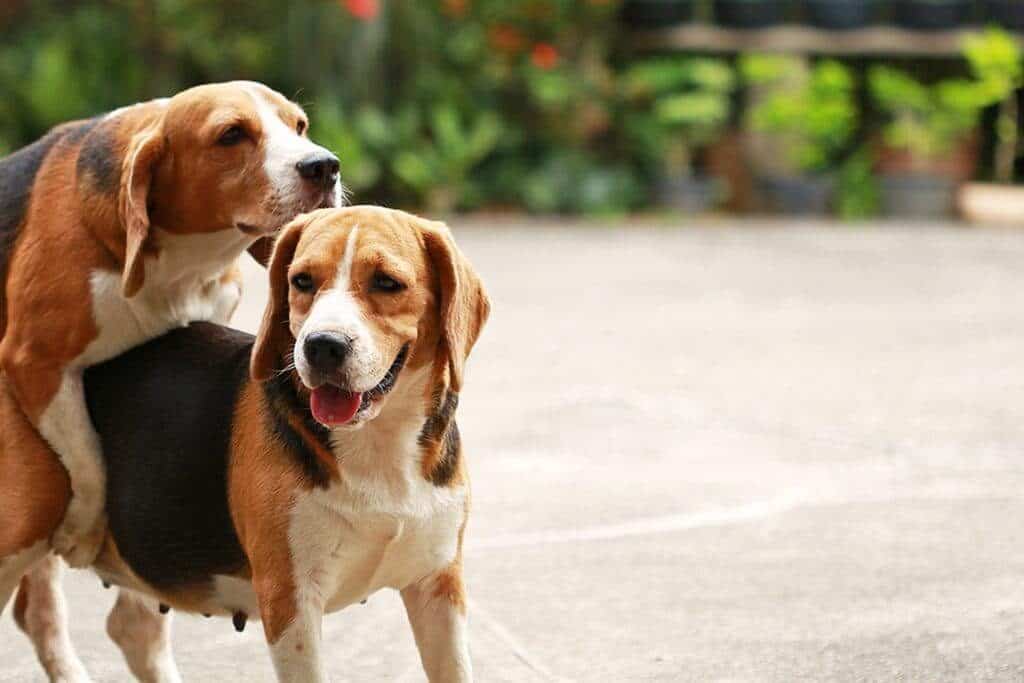
Whenever dogs are in heat, they leave a very obvious smell in their urine and vaginal discharges. These scents attract male dogs from miles away.
If they are brought any closer, these male dogs are easily prone to jump on them and mate, and every dog in heat will allow this to happen.
If this does not happen, any female dog who is suddenly attracted to other male dogs after seeing them and starts walking differently, you should know your dog is in heat.
Since male dogs have such a powerful attraction towards female dogs in heat, it is advised that humans must thoroughly wash their clothes after coming in contact with a dog who is in heat.
Otherwise, they may aggressively interact with a human because of picking up the scent.
What Are The Stages Of The Estrus Cycle?
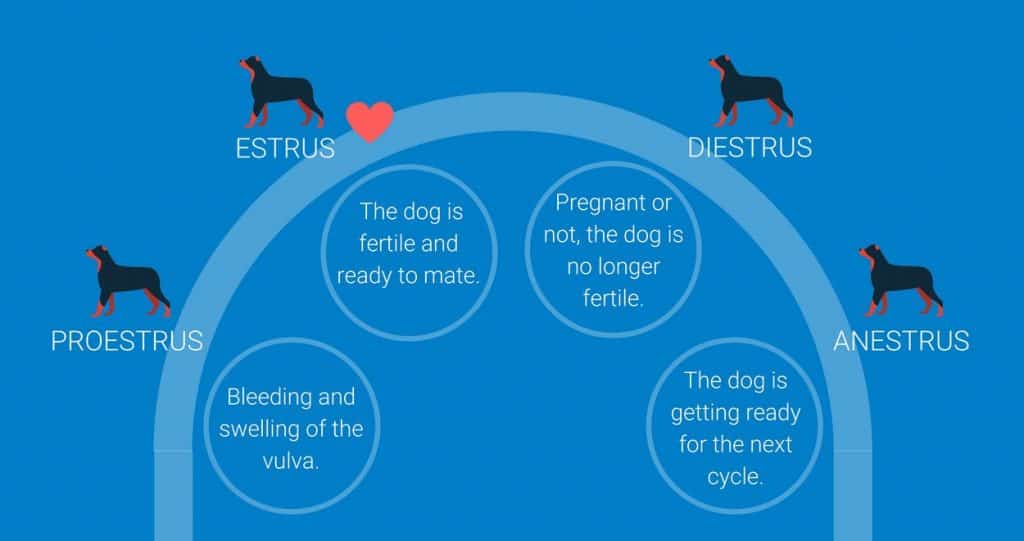
There are name four stages in this cycle that differ in terms of duration. These are proestrus, estrus, diestrus, and anestrus.
All these stages exhibit different levels of changes in behavior, cytologic (vaginal smear) changes, hormonal changes, clinical or physical changes, and physiological changes.
Here is a detailed description of dog in heat stages and all the changes that are associated with it.
1. Proestrus Stage:

In this stage, you may start to notice changes that indicate that your dog is in “heat” or just beginning the estrus cycle. The duration of this stage is about an average of 9 days, however, it can go about 27-28 days, depending on your female dog’s breed, size, and overall characteristics.
During this time, males will be attracted to female dogs, more than they usually are. The smell of the bloody discharge can be detected or picked up by male dogs very easily.
However, female dogs in heat will not be receptive to the sexual advances of male dogs.
In female dogs, the estrogen levels peak and follicles, that are small secretory cavities will start to develop.
There is blood-tinged discharge, that usually starts as light pink and gradually turns to reddish in color. The vulva is generally swollen throughout this stage.
The vaginal cytology shows mixed typed of cells, often containing red blood cells.
2. Estrus Stage :
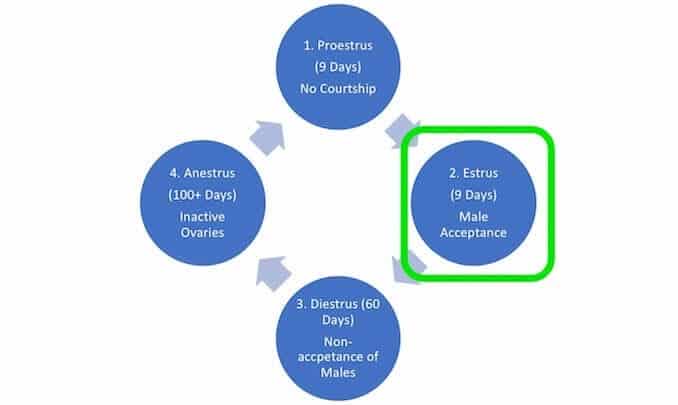
In the Estrus stage, the female dogs in heat will reciprocate the advances of the male dogs.
This stage is said to last about 9 days but can range anywhere between 4 to 24 days. Behaviourally, this stage is about 10 days long.
There are substantial changes that occur in female dogs in heat.
This stage is also called the fertile period, as fertility occurs in dogs during this time.
Vulvar discharge starts to decrease, the color of the discharge becomes less bloody. In the Estrus stage, the estrogenic levels begin to drop, and there is a significant rise in progesterone levels.
Progesterone is a hormone produced by the ovaries and placenta that helps maintain pregnancy. Since this is the stage of fertility, the female dog’s body begins to start preparing itself, if anything happens.
Vaginal cytology indicates predominantly flattened epithelial cells.
3. Diestrus Stage:

After the estrus stage is over, comes the diestrus stage.
In the diestrus stage, the female dog is no longer receptive to the male dogs.
This stage is unlike the first two, in duration, it is longer and lasts about two months. Estrogen levels are low.
However, progesterone levels peak 3-4 weeks after the advent of the diestrus stage. It declines and reaches the basal levels at the end of the diestrus stage.
This increase and decrease in progesterone levels will happen irrespective of the dog’s pregnancy.
Vaginal cytology will indicate a shift towards basal cells, with fewer blood cells than in proestrus.
4. Anestrus:

This is the time between the diestrus and the following proestrus.
This stage averages about 4 months in duration, varying from breed to breed. The vulva is back to its original shape, it is no longer swollen.
Vaginal discharge terminates, in all kinds. There is no bloody or whiteish discharge. The body, in the anestrus stage, uses this time to let the uterus prepare for the next probable pregnancy.
Vaginal cytology indicates basal cells, everything goes back to normal.
Dogs In Heat Behavior
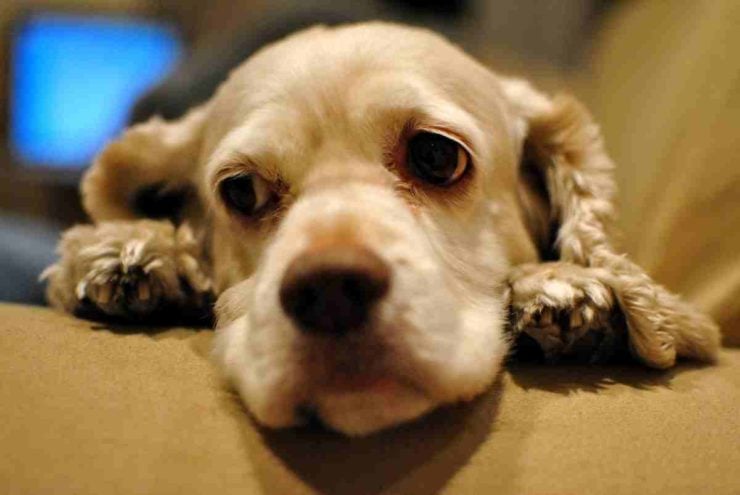
It is a very painful time for your female dog in heat, especially if dogs in first heat.
Certain things need to be kept in mind, that your dog is going through bodily changes, her body is maturing, she will be moody and aggressive.
Here’s how to tell if your dog’s in heat:
Since the beginning, you can trace changes in your dog’s behavior. Some dogs become very restless, mostly, but it is not unusual if your dog exhibits the opposite behavior.
If she becomes less active, you should cuddle with her more often and give her all the love she needs.
In fact, whenever female dogs in heat signs are easily noticeable.
Even though during this time your female dog will be attractive to ale dogs she will be unwilling to breed.
If a male dog is persistent, she may get aggressive to shoo them away. It will also make her reluctant to let her touch you as well.
Behavioral changes are not pronounced in dogs in heat cycle in the beginning.
During the heat cycle, your dog’s body temperature may be higher than usual. It is advised that you measure her temperature from time to time.
You must keep in mind that this could also pan out a wide range of medical conditions, contact your vet if you notice something unusual.
During this time your dog will lick her genital area more often, to clean the flowing discharge. If you pay attention to your dog, you will find her cleaning up after herself.
Cleaning the spotting on the floor may be a tiresome nut if your dog has a knack for cleaning up after herself that won’t be an issue.
Your dog may also lose her appetite, as most dogs do.
In this cycle, additional energy is required to stay active, if your dog becomes lethargic or less active, she may lose her appetite and eat in smaller quantities. You might have to feed her if she refuses to or cannot eat.
In the second stage, however, your dog will be willing to mate with male dogs. If you want to prevent your dog from getting pregnant, you will have to keep her away from other dogs.
If your dog was extremely quiet in the first stage, proestrus, you’re in for a ride. The reason behind this is that your dog is in need of a particular something, she will not calm her horses till she gets it.
This can be seen in her increase in activity, alertness towards faint noises. She will become excessively vocal, barking and howling, to gasping and sleep disorders.
There will be changes in gait and tail wagging, to attract males. This is somewhat equivalent to human flirting.
She may swing her hips and wag her tail high up as she walks. This is to invite male dogs.
In this stage, there will be an increase in urination. Urine is sort of a telltale marker to male dogs that the female is in heat.
She will dispense in various locations frequently. It occurs in the first stage of heat; however, it becomes more prominent in the second stage.
Behaviors will differ in your dog in heat stages accordingly.
Suggested: Dog Pregnancy.
Tips On How To Take Care Of Your Dog In Heat
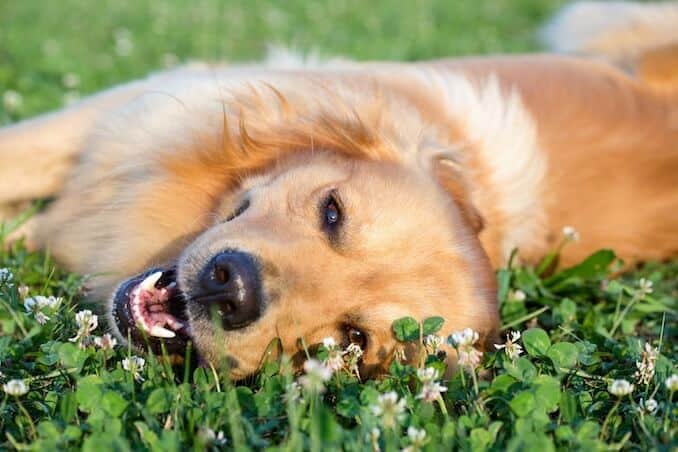
Most people adopt one of two ways pertaining to the care and treatment of dogs in heat.
Either they freak out and take extra care, take days off from work, change diaper pads frequently or they just stick to a routine and treat their dog as usual.
Here are a few tips to care for your dog in heat:
1. Give Her Extra Attention:
It is not just physically that your dog is experiencing changes but mentally too. Make sure you spend extra time around her during this time, your presence will make her feel cared for and safe. You could take her out for walks, caress her hair and brush her often or talk to her, etc.
2. Maintain A Balanced Exercise And Rest Routine:
Many dog breeds react differently to heat. Some dogs are highly energetic during the heat cycle whereas some are lousy and lazy. You should add a perfect mix of exercise and rest to keep your dog healthy and comfortable.
3. Don’t Let Your Dog Off The Leash:
Take your female dog out for walks like you normally do, it is not a problem. What could be a problem however is leaving your dog off the leash, she will refuse your commands and follow her instincts.
4. Don’t Leave Your Dog Unattended Outdoors:
If you want to avoid pregnancy, you should keep your dog inside. Male dogs will find her. This does not affect whether you want to breed your female or not. You must protect your dog from male dogs.
5. Leave Toys And Chews:
If you’re leaving for work or college, you might want to leave a few toys and chews. Dogs get extremely mouthy during this time as it helps them cope with stress. Stress is why dogs tend to chew objects. This will keep her busy in your absence and drive her restlessness away.
6. Hide Trails Back Home From Male Dogs:
You don’t want a male dog tracking down your female dog on her way back home from her walk, do you? Male dogs can be psycho stalkers too when they smell a female dog in heat. You could drive your dog to the walking spot, a few blocks from your house. This way your home s off the radar of male dogs.
7. Apply Some Menthol At The Tail Of The Dog:
Whenever you take your dog outside, the menthol that is applied helps to mask the scent. It does not effectively work but you could try it yourself.
8. No Group Training Or Dog Shows:
You should try to avoid contact with other dogs. Especially training shows or dog shows. A female dog in heat could distract the male dogs, infringing their performance.
9. Use Dog Panties Or Pants:
The bloody discharge could ruin your carpet or your furniture. If your dog is comfortable with having diapers on her, you may use them. They reduce the odor and doesn’t leave a smell tracing back to your house. However, this won’t prevent a male dog from mounting on her if he sees her, so don’t let male dogs approach during walks.
10. Consult A Vet:
If you experience any unusual trouble or any problem in general, contact the vet immediately. Even if you don’t, it’s always safe to consult a vet.
11. Spaying:
Consider spaying your dog if you are not going to breed her. There are many advantages of spaying a dog such as the prevention of mammary cancerous tumors and unexpected pregnancies.
Did we answer all your questions?
Yes? Great! We would love to hear your thoughts in the comment section.
No? Here is a blog by AKC that might help.
Stay with us to know more about dogs and dog breeds.



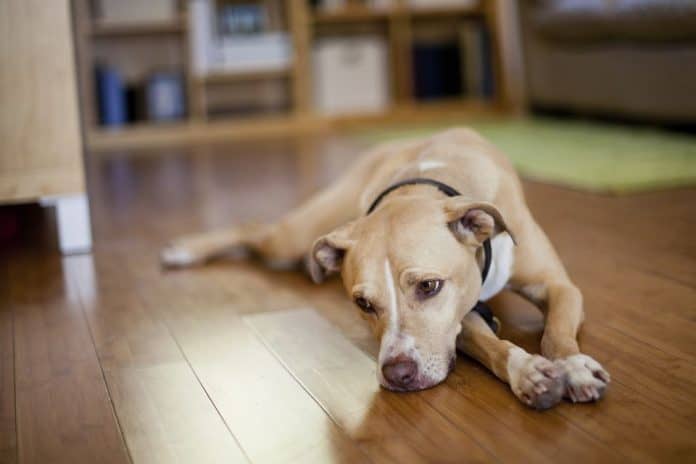









[…] Suggested: Dogs In Heat […]
[…] Dogs in heat is one concept that many people are still unaware of. Dogs in heat means a dog reaching its sexual maturity and being further able to reproduce. […]
Very informative, thank you! I now feel better equipped to provide what my little canid needs in this time in her life.